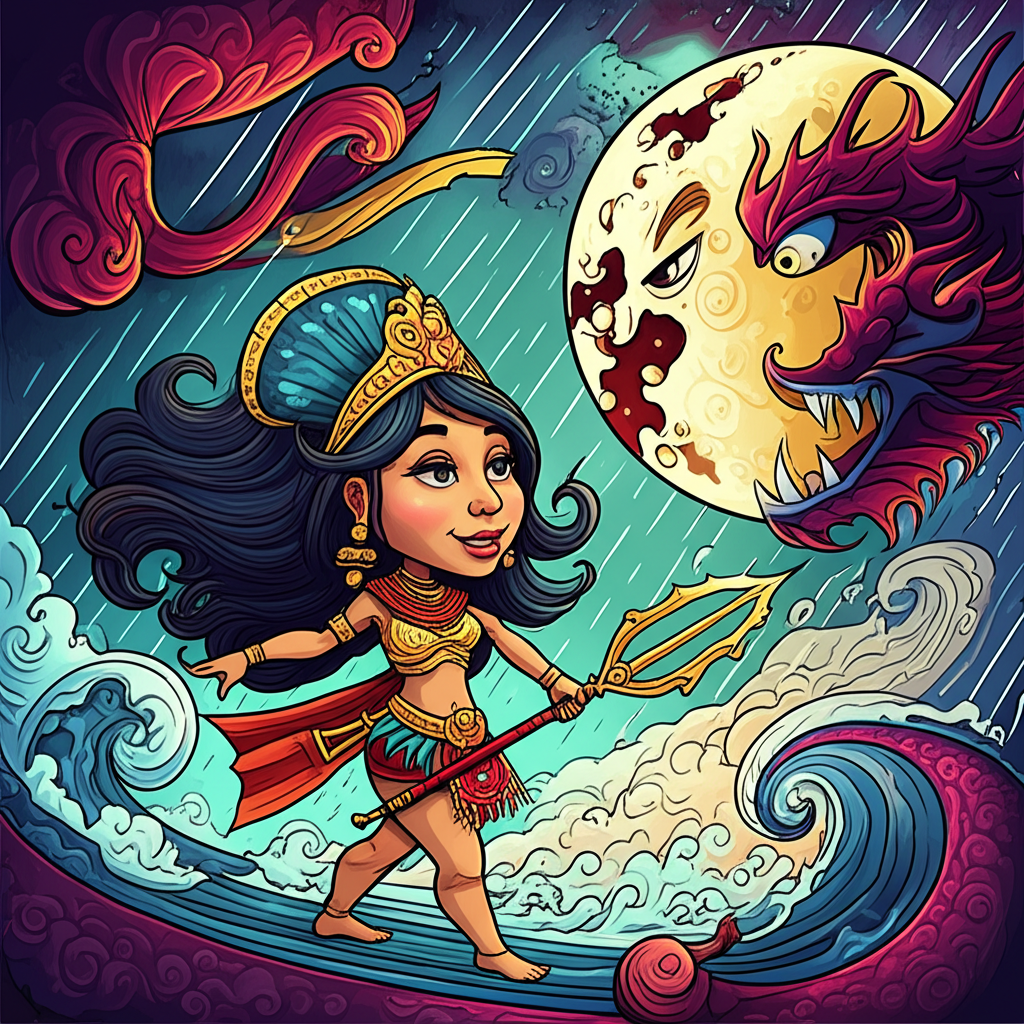
The islands of the Philippines, a vibrant archipelago teeming with emerald jungles, sapphire seas, and skies painted with the fiery hues of dawn and dusk, are a cradle of rich folklore. Among the myriad of tales whispered down through generations, one of the most captivating speaks of Anitun Tabu, the deity of winds, and her fateful encounter with the mythical serpent of the sea, Bakunawa. This is not a chronicle of divine decree, but rather a narrative woven from the threads of ancient imagination, a testament to how early peoples sought to explain the mysteries of the cosmos and the elemental forces that shaped their lives.
Origins and Cultural Tapestry: A World of Spirits and Cycles
The myth of Anitun Tabu and Bakunawa likely emerged from the pre-colonial era of the Philippines, a time when the world was perceived as a dynamic, interconnected realm inhabited by a pantheon of spirits, deities, and powerful beings. The environment was paramount. Life revolved around the rhythms of nature: the predictable cycles of the sun and moon, the capricious moods of the sea, the life-giving force of the rain, and the ever-present, often destructive, power of the winds.
In this worldview, natural phenomena were not merely random occurrences. They were the manifestations of the actions and intentions of these unseen entities. The solstices and equinoxes, eclipses, storms, and calm seas were all imbued with meaning, interpreted as blessings, warnings, or pronouncements from the spiritual realm. The people of that era lived in close communion with their environment, their survival dependent on understanding and respecting its delicate balance. Their stories served as a framework for this understanding, offering explanations for the inexplicable and providing a moral compass for their societies.
Anitun Tabu and the Cosmic Serpent: Figures of Elemental Power
Anitun Tabu, as depicted in these ancient narratives, is the embodiment of the wind. She is not a singular entity in the same way a human is, but rather a powerful, pervasive force. Her essence is the breath of the world, the unseen hand that rustles the leaves, whips the waves into a frenzy, and carries the seeds of life across vast distances. In some interpretations, she is depicted as a benevolent spirit, her gentle breezes nurturing crops and her refreshing gusts bringing relief from the heat. In others, she is a tempestuous force, her fury capable of uprooting trees and devastating villages, mirroring the destructive potential of powerful storms. Her symbolic attribute is the ephemeral nature of air itself – omnipresent yet intangible, powerful yet easily swayed.
Bakunawa, on the other hand, is a creature of immense, primordial power, often described as a colossal sea serpent or dragon. Its domain is the abyssal depths of the ocean, a realm of mystery and unknown forces. Bakunawa is frequently associated with the moon, and its legendary appetite for this celestial body is a recurring theme in various Philippine mythologies. Symbolically, Bakunawa represents the untamed, chaotic forces of nature, particularly those that lie hidden beneath the surface. It embodies primal fear, the vastness of the unknown, and the cyclical, often terrifying, events that could disrupt the perceived order of the world. Its serpentine form suggests fluidity and adaptability, while its size signifies an overwhelming, almost insurmountable, power.
The Celestial Dance: Anitun Tabu and the Oath of Bakunawa
The narrative of Anitun Tabu and the Oath of Bakunawa often unfolds as a dramatic celestial event. In the ancient understanding, the moon was not a distant, inert rock, but a luminous orb vital to the cycles of life, influencing tides, the growth of plants, and perhaps even the very temperament of creatures. Bakunawa, driven by an insatiable hunger, would periodically rise from the ocean’s depths, its massive form eclipsing the light of the moon.
The ancient peoples, observing these lunar eclipses, would interpret them as Bakunawa attempting to devour the moon. Fear would grip communities, and rituals would be performed to ward off the serpent and protect the celestial light. It was in this context of cosmic drama that Anitun Tabu, the guardian of the skies and the mistress of the winds, would intervene.
Imagine a night, darker than any before, the familiar glow of the moon gradually being consumed by an encroaching shadow. The sea, usually a source of sustenance and life, would churn with an unnatural unrest, mirroring the turmoil in the heavens. From the deepest trenches, Bakunawa would ascend, its scales shimmering with phosphorescent light, its serpentine body coiling around the moon like a suffocating embrace. The world held its breath.
Then, a sound would begin to fill the air – a low, resonant hum that grew into a mighty roar. This was the awakening of Anitun Tabu. Her spirit, woven into the very fabric of the atmosphere, would gather its strength. The winds, once gentle whispers, would transform into powerful gales, lashing at the sea and creating tumultuous waves. Anitun Tabu, though unseen, would manifest her presence through the fury of the storm.
The battle would be titanic. The winds would howl, attempting to pry Bakunawa from its celestial prey. The earth would tremble under the strain of the cosmic struggle. The ancient stories do not detail a physical combat, but rather a powerful negotiation or an oath. Anitun Tabu, with her dominion over the air, would exert her influence, not through brute force alone, but through a profound understanding of the elemental balance.
It is said that Anitun Tabu, through her powerful winds, would create a cacophony, a celestial clamor designed to disorient and perhaps even discomfort Bakunawa. This sustained atmospheric pressure, coupled with the deafening roar of the winds, would force the serpent to reconsider its actions. In some versions, Anitun Tabu would make an oath, a promise of appeasement or a pact that would ensure Bakunawa’s return to the depths. This oath, carried on the breath of the wind, would bind the serpent. Perhaps it was a promise of offerings from the sea, or a specific period of time before its next attempt, or a guarantee of its eventual return to the dark abyss.
Whatever the specifics of the oath, the result was always the same: Bakunawa would release its grip on the moon. The shadows would recede, and the moon’s luminous glow would be restored, bathing the world once more in its gentle light. The winds would gradually subside, leaving behind a calm sea and a sense of profound relief. The ancient people, emerging from their fear, would see the restored moon as a victory, a testament to the power of the celestial forces that protected them.
Symbolism and Meaning: Reflections of the Ancient Mind
The myth of Anitun Tabu and the Oath of Bakunawa is rich with symbolism, offering insights into the worldview of its ancient creators.
- The Moon: The moon, as a central element, represented order, cycles, and a vital source of light and guidance in the darkness. Its vulnerability symbolized the precariousness of this order.
- Bakunawa: The serpent’s attempt to devour the moon spoke to the primal fear of chaos and destruction, the ever-present threat of the unknown that could disrupt the established order. It also represented the immense, untamed power of the ocean, a force that could be both life-giving and devastating.
- Anitun Tabu: Her intervention symbolized the power of the elemental forces that governed the natural world, particularly the winds. She represented the protective aspects of nature, the unseen forces that could restore balance and safeguard existence. Her role also hinted at the concept of divine or elemental intervention to maintain cosmic harmony.
- The Oath: The oath itself signified the importance of pacts, agreements, and the establishment of boundaries, even between primordial forces. It suggested a belief that even the most chaotic elements could be appeased or contained through established agreements, reflecting a human desire for predictability and control.
Ultimately, the story served as an imaginative explanation for lunar eclipses, a phenomenon that would have been awe-inspiring and terrifying to ancient observers. It provided a narrative framework that allowed them to understand and cope with such events, imbuing them with meaning and reassuring them that protective forces were at play.
Modern Echoes: Literature, Games, and Cultural Appreciation
In the modern era, the myth of Anitun Tabu and Bakunawa continues to resonate, albeit in different forms. These ancient stories are no longer interpreted as literal accounts of divine or mythical interactions, but rather as valuable pieces of cultural heritage.
In literature, these figures and narratives are often reimagined by Filipino authors, drawing inspiration from their rich folklore to create new stories, poems, and novels that explore themes of identity, nature, and the human condition. Bakunawa, in particular, has gained significant traction in the realm of popular culture. Its fearsome visage and its association with the moon have made it a compelling antagonist or a powerful mythical creature in video games, often depicted as a formidable boss that players must defeat. Its image can be found in various forms of visual art, from paintings to digital illustrations, celebrating the vibrant tapestry of Philippine mythology. In academic circles, these myths are studied as part of cultural anthropology and comparative mythology, providing insights into the beliefs, values, and historical context of ancient Filipino societies.
A Legacy of Storytelling
It is crucial to reiterate that the tales of Anitun Tabu and the Oath of Bakunawa are ancient stories, products of the rich imagination and interpretive frameworks of our ancestors. As Muslims, we recognize that only Allah (God) is the true Creator and Sustainer of all that exists, and that all power and dominion belong to Him alone. These narratives, therefore, are not to be believed as divine truths, but appreciated for their cultural significance.
These myths stand as enduring testaments to the human need to understand the world around us, to find meaning in the vastness of the cosmos, and to articulate our fears and hopes through the power of storytelling. They remind us of the enduring legacy of our cultural heritage, a heritage that continues to inspire, educate, and connect us to the imaginative spirit of those who came before. The whispers of the celestial serpent and the breath of the wind continue to echo, not as pronouncements of faith, but as vibrant threads in the rich tapestry of human storytelling.





